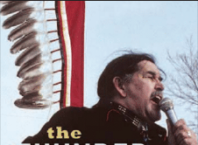Composer Brent Micheal Davids (Mohegan) arrived in West High School in Mankato, Minnesota to record ten minutes of original composition with Ken Freed and the Mankato Symphony Orchestra for a new film, “Ohiyesa: The Soul of an Indian,” produced by filmmaker Sydney Beane.
Fifty some orchestra players gathered to rehearse and perform the new piece composed especially for the film’s trailer. Davids, a classically trained composer, wrote the score in just a matter of a few days after learning of the project.
Guitarist Johnny Beane joined Freed and orchestra in Mankato to perform as a soloist for the project. Film scores require that each ‘cue’ match each cut as the film moves scene to scene. This project included twelve such cues and was recorded in one day. The fine tuning of the film’s score was completed in David’s studio in St. Paul in mid-August.
Davids has composed scores for several feature films over the course of his career including Last of the Mohicans, The Business of Fancy Dancing, The Silent Enemy, and Bright Circle.
Once the film is completed Beane and Davids hope to work together to create the entire score. The film documents the life of Ohiyesa (Charles Eastman), the Dakota physician who witnessed the massacre at Wounded Knee in 1892, and whose life’s work included the publication of two books on Dakota culture.
Beane, a descendant of Eastman, believes that his relative’s life should be portrayed as accurately as possible. The film is told through the eyes of Carly Beane, Sydney’s daughter, a graduate student at the University of Minnesota. For the purposes of reflecting on Eastman’s career as a writer, Carly Beane interviewed Minneapolis based novelist Louise Erdrich – who credits Eastman as having been influential in the development of her own career. Beane hopes to complete the film in the coming year.
Davids, Beane, and Freed also hope to work together on a longer piece of orchestral music in memory of the 38 Dakota men who were executed in Mankato. The hangings occured in the late 19th century following the Dakota conflict.






